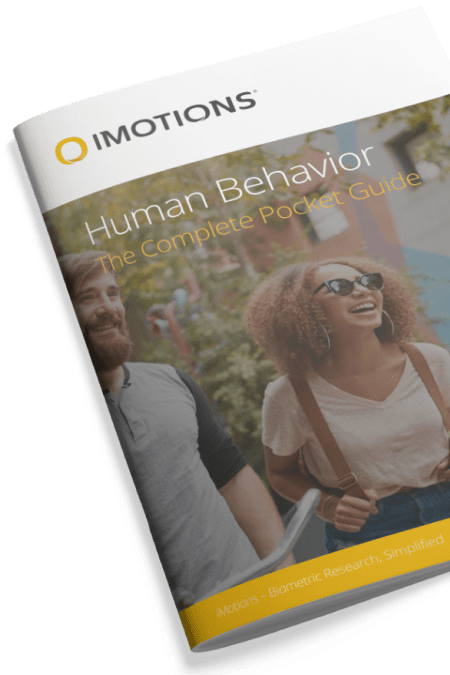Discover the importance of measuring the four types of attention-sustained, selective, alternating, and divided-with biosensors. This comprehensive guide explores how each attention type impacts daily activities and cognitive processes, enhancing everything from educational success to automotive design. Learn about the tools and methods used to assess attention, including EEG, eye tracking, and more, offering a deep dive into the roles and measurement strategies of attention in various settings.
Table of Contents
Please pay attention!
Thank you.
For many of us, the concept of attention is an either/or thing. Either you pay attention to something or you do not. However, attention is much more than just that. Attention is a cornerstone of human cognition, critical for navigating and interacting with our arguably complex world. In human behavior science and research, the study of attention is not just about understanding how we concentrate but about dissecting the nuances of how we manage different streams of information that our environments perpetually throw at us. The research into attention is the research of how we exert agency in our daily lives; when we are at work, driving a car or even when cooking dinner.
There are four different types of attention-sustained, selective, alternating, and divided-and they each play a distinct and crucial role in our daily activities and cognitive processes. This article delves into why it is imperative to research these different attention types, exploring their impact on everything from educational success and workplace productivity to clinical diagnoses and technological advancements. By examining how these forms of attention function and interconnect, we can better appreciate their significance in cognitive development, behavioral outcomes, and overall mental health.
Let us begin by taking an in depth look at the different types of attention and what makes them significant.

Sustained Attention
1. Sustained Attention
Sustained attention, often termed as vigilance, encompasses the ability to continuously focus on a particular task or stimulus over an extended duration. This aspect of attention is indispensable in various occupational and everyday settings where continuous concentration is required despite minimal variations in the intensity or nature of the stimulus.
Definition and Characteristics
Sustained attention is defined by psychologists as the capacity to direct and focus cognitive activity on specific stimuli or activities over prolonged periods. It is characterized by the endurance of attentional performance when faced with repetitive, unstimulating tasks. The core challenge in sustained attention is maintaining a vigilant state in environments where stimuli are not inherently engaging or when tasks do not frequently change, which can lead to decreased alertness and performance over time.
Importance of Sustained Attention
The role of sustained attention is critical in numerous fields. In air traffic control, for example, operators must monitor radar screens continuously for potential conflicts between aircraft. Similarly, researchers reading lengthy and complex academic papers rely on this type of attention to process detailed information effectively. In everyday life, driving for long distances without much variation in the road or traffic conditions requires a high level of sustained attention to ensure safety.
Traditional Measuring of Sustained Attention
Sustained attention is typically measured through tasks where individuals must detect rare or irregular signals over an extended time. The Mackworth Clock Test is a classic example, where subjects must watch a clock with a second hand that skips at irregular intervals. Reaction time and accuracy in acknowledging these skips are indicators of an individual’s sustained attention capabilities.
Factors Influencing Sustained Attention
Several factors can affect the ability to maintain sustained attention. Cognitive load, the complexity of the task, and individual differences such as age, sleep patterns, and mental health status can all influence performance. For instance, higher cognitive loads can reduce the duration an individual can maintain effective focus, while adequate sleep and good mental health can enhance it.
Strategies to Enhance Sustained Attention
Improving sustained attention involves both environmental adjustments and personal strategies. Reducing distractions in the environment, taking regular breaks, and segmenting work into shorter periods can help maintain focus. Additionally, practices such as mindfulness meditation have been shown to improve concentration and overall attentional control.
Sustained attention – Overview:
- Essential for tasks requiring continuous performance.
- Can degrade over time due to fatigue, leading to what’s known as “vigilance decrement.”
- Associated with activity in the frontal and parietal lobes of the brain, areas involved in managing high-level cognitive functions.

Selective Attention
2. Selective Attention
Selective attention is a fundamental cognitive process that involves concentrating on one particular element in the environment while excluding other potential distractions. Think of it as shining a spotlight on a specific spot, making it the focus of gaze while the rest fades into the background. This ability plays a critical role in everyday functionality, enabling individuals to navigate complex environments and maintain focus on tasks at hand.
Definition and Characteristics
Selective attention allows an individual to select and process certain relevant stimuli while filtering out others that are deemed less important at the moment. This process is essential in situations where numerous stimuli compete for cognitive processing. Selective attention is dynamic, adaptable to different contexts, and crucial for efficient interaction with one’s surroundings.
Importance of Selective Attention
The importance of selective attention is evident in both routine and complex activities. For example, a student may need to focus on a lecturer’s words despite background chatter in the classroom. In more dynamic settings, such as playing sports, an athlete must focus on the ball and relevant players, ignoring the crowd and other less relevant stimuli.
Traditional Measuring of Selective Attention
Researchers often assess selective attention through various tasks that require participants to respond to specific stimuli amidst distractors. One common method is the Stroop Task, where individuals must name the color of the word being displayed, which itself can be a conflicting color name, requiring the participant to ignore the word and focus on the color.
Factors Influencing Selective Attention
Multiple factors can impact the efficiency of selective attention, including but not limited to, the individual’s alertness, the salience of the stimuli, and the complexity of the surrounding environment. Alertness can be influenced by factors like fatigue and stress, while stimulus salience involves properties that naturally draw attention, such as motion or high contrast.
Strategies to Enhance Selective Attention
Improving selective attention involves both cognitive strategies and environmental management. Techniques such as practice and training can enhance one’s ability to focus amidst distractions. Environmental strategies might include minimizing potential distractions in one’s immediate surroundings, such as turning off unnecessary screens, clearing clutter from the workspace, and/or turning off background music.
Selective attention – Overview:
- Enables the processing of relevant information and the exclusion of irrelevant data.
- Involves both the enhancement of the selected stimulus and the suppression of non-selected stimuli.
- The brain’s reticular activating system (RAS) plays a key role in filtering stimuli before processing in higher brain centers.

Alternating Attention
3. Alternating Attention
Alternating attention, also known as selective attention, is the type of attention that allows people to shift focus between tasks that demand different cognitive resources. This capacity for flexibility is valuable when navigating tasks with diverse requirements, facilitating easy transitions between activities of varying nature. Alternating attention reflects cognitive flexibility and the executive control of attention, both crucial components of efficient cognitive functioning.
Definition and Characteristics
Alternating attention refers to the ability to redirect cognitive resources from one task to another, adjusting focus as necessary to meet the demands of each activity. Unlike sustained attention, which involves maintaining focus over time, alternating attention involves dynamically switching between tasks or stimuli with differing cognitive demands. This ability is vital in environments where multiple tasks compete for cognitive resources and prioritization is necessary.
Importance of Alternating Attention
The ability to alternate attention between tasks is invaluable in numerous aspects of daily life and professional endeavors. For instance, in a work setting, an individual may need to transition from a creative brainstorming session to a detailed analytical task seamlessly. Similarly, in academic settings, students must shift focus between subjects requiring different cognitive skills, such as math and language arts.
Measuring Alternating Attention
Assessing alternating attention often involves tasks that require individuals to switch between different types of stimuli or cognitive operations. For example, the Trail Making Test assesses alternating attention by asking participants to connect a series of numbered and lettered dots in alternating order. Performance on such tasks provides insights into an individual’s ability to flexibly shift attention between different types of stimuli.
Factors Influencing Alternating Attention
Several factors can influence an individual’s ability to alternate attention effectively. These may include cognitive factors such as working memory capacity and processing speed, as well as external factors such as distractions and task complexity. Additionally, factors like fatigue and stress can impact cognitive flexibility and the ability to switch between tasks efficiently.
Strategies to Enhance Alternating Attention
Enhancing alternating attention involves employing strategies that promote cognitive flexibility and task-switching efficiency. Engaging in activities that challenge cognitive flexibility, such as puzzles and brain games, can help improve this skill over time. Additionally, practicing mindfulness techniques can aid in managing distractions and maintaining focus during task transitions.
Alternating attention – Overview:
- Involves the ability to disengage attention from one task and move it to another.
- Requires executive control processes, which are primarily mediated by the prefrontal cortex.
- Important for multitasking and adjusting to changing task demands or environments.

Divided Attention
4. Divided Attention
Lastly, we come to divided attention, commonly referred to as multitasking. Divided attention involves the ability to handle more than one task or process multiple sets of stimuli at the same time. This capability is crucial in our modern, fast-paced world where individuals often juggle various tasks simultaneously. However, true multitasking is a complex cognitive feat, and what is often perceived as multitasking may actually be rapid task-switching, which creates an illusion of simultaneous activity.
Definition and Characteristics
Divided attention refers to the allocation of cognitive resources to several tasks at once. It requires the simultaneous handling of multiple demands, which can vary widely in nature and complexity. The efficiency of divided attention depends largely on the tasks involved; simpler, well-practiced tasks require less cognitive effort and are more easily combined than complex, novel tasks.
Importance of Divided Attention
The ability to divide one’s attention is increasingly important in various settings, from professional environments where employees may need to manage emails while attending meetings, to personal scenarios such as conversing while driving. Effective divided attention can enhance productivity and is often seen as a valuable skill in multitasking environments.
Measuring Divided Attention
Divided attention is typically assessed through tasks designed to require simultaneous engagement in multiple activities. One common method is the dual-task paradigm, where subjects perform two tasks concurrently, such as recalling words while sorting cards. The performance on these tasks helps measure how well attention is divided and the impact of interference between tasks.
Factors Influencing Divided Attention
Several factors can impact the ability to effectively divide attention. These include the complexity and familiarity of the tasks, the individual’s cognitive capacity, and environmental factors like noise and interruptions. Additionally, individual differences such as age, cognitive flexibility, and working memory capacity play significant roles in multitasking ability.
Strategies to Enhance Divided Attention
Improving divided attention involves training and strategic management of tasks. Cognitive training exercises designed to enhance working memory and processing speed can improve multitasking performance. Practically, it is also helpful to prioritize tasks, minimize distractions, and create an environment conducive to focus. Learning to recognize the limits of one’s capacity to divide attention can also aid in managing tasks more effectively.
Divided attention – Overview:
- Involves managing multiple streams of information and engaging in more than one task concurrently.
- The efficiency of divided attention can vary greatly depending on the individual’s skill level, task familiarity, and cognitive load of the tasks.
- Often leads to a reduction in performance quality or speed compared to when tasks are performed separately, a phenomenon known as the “dual-task interference effect.”
Measuring Attention with Biosensors
Measuring attention has traditionally been done through the performance of tasks such as the aforementioned Stroop Test, Trail Making Test, and the Continuous Performance Test (CPT) among others. These tasks have traditionally been analyzed and tracked through traditional means such as interviews and questionnaires. However, with biosensors and the iMotions software suite, it is possible to have a real-time data feed of respondents engaging in cognitive tasks, and therefore have a much larger amount of actionable data at hand. Various biosensors and techniques are can be employed to measure the 4 types of attention, including:
- Electroencephalography (EEG): This measures electrical activity in the brain and can indicate levels of focus or distraction. Specific EEG patterns, such as event-related potentials (ERPs), can be linked to different types of attention.
- Eye Tracking: By tracking where and how movement occurs, eye trackers can infer where attention is focused. Saccades (rapid eye movements) and fixations (where the gaze is held) can indicate selective attention, for example.
- Heart Rate Variability (HRV): Changes in HRV can reflect the autonomic nervous system’s response to cognitive load or stress, indirectly indicating levels of sustained or divided attention.
- Galvanic Skin Response (GSR): Also known as Conductance Response (SCR), measures changes in sweat gland activity, which can increase during periods of high cognitive load or stress, indicating levels of engagement or attention.
- Functional Magnetic Resonance Imaging (fMRI): fMRI can show which areas of the brain are active during tasks that require different types of attention. For example, tasks requiring sustained attention might show prolonged activity in the prefrontal cortex.
By analyzing data from these biosensors, researchers can infer which type of attention is being engaged. For example, high levels of sustained attention might be indicated by steady EEG patterns, specific fMRI activity in attention-related brain regions, stable eye fixation on a task-relevant stimulus, and certain patterns of HRV and SCR. In contrast, divided attention might show more scattered eye movements, different brain activation patterns, and varied HRV and GSR readings due to the multitasking nature of the task.
The Advantages of a Multimodal Research Approach in Attention Studies
A multimodal research approach integrates multiple biosensors to provide a detailed and nuanced understanding of attentional processes. This method enhances accuracy through cross-validation of data from different sensors like EEG and fMRI, confirming reliability when both indicate similar brain activity during tasks. It enables comprehensive data collection by combining the temporal resolution of EEG with the spatial resolution of fMRI, supplemented by eye tracking to reveal visual focus, and HRV and SCR data reflecting the autonomic nervous system’s role.
This approach not only broadens the scope of data but also deepens insights into the complex dynamics of attention involving cognitive and emotional interplays. For instance, correlating neural and physiological responses helps examine how attention fluctuates with emotional states or stress. Moreover, the use of diverse biosensors helps identify specific patterns or biomarkers crucial for differentiating between attention-related conditions, which is particularly useful in clinical settings to tailor interventions or treatments.
Ultimately, adopting a multimodal strategy in attention studies enables personalized approaches by pinpointing individual differences, thereby enhancing interventions in educational, therapeutic, or professional contexts. This comprehensive method advances both the theoretical understanding and practical applications in cognitive neuroscience and psychology, reflecting the multifaceted nature of attentional processes.
Practical Application of Attention Measuring
Attention measurement is crucial in several areas, significantly impacting performance, safety, and effectiveness. Here are three main areas where measuring attention is a central component:
Automotive Human Factors Design: Attention measurement is essential in designing automotive systems to ensure driver safety and performance. By monitoring where and how a driver’s attention is directed, designers can create more effective warning systems, ergonomic controls, and interfaces that keep drivers focused on the road. Technologies such as eye tracking and EEG provide insights into driver distraction and cognitive load, facilitating the development of vehicles that better engage and support the driver.
Educational Settings: In education, understanding student attention can greatly enhance learning outcomes. Measuring attention helps educators tailor teaching methods to maintain or regain student focus, particularly in environments rich with potential distractions. Techniques like eye tracking and real-time attention tracking software can identify when a student’s attention wanes, allowing for immediate pedagogical adjustments.
Clinical Psychology and Psychiatry: Attention measurement is integral to diagnosing and treating disorders such as ADHD, anxiety, and depression. Tools like continuous performance tasks (CPT) or neuroimaging are used to assess attentional capacities and deficits. This not only helps in accurately diagnosing attention-related disorders but also in monitoring the effectiveness of therapeutic interventions, adjusting treatments to better suit individual patient needs.
Free 52-page Human Behavior Guide
For Beginners and Intermediates
- Get accessible and comprehensive walkthrough
- Valuable human behavior research insight
- Learn how to take your research to the next level












